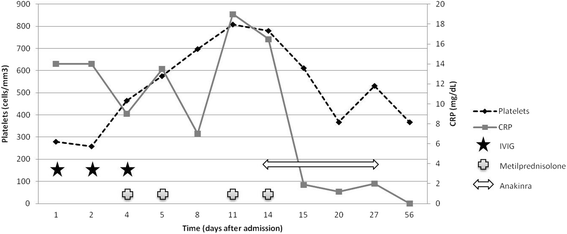A child with resistant Kawasaki disease successfully treated with anakinra: a case report
- PMID: 28390409
- PMCID: PMC5385011
- DOI: 10.1186/s12887-017-0852-6
A child with resistant Kawasaki disease successfully treated with anakinra: a case report
Abstract
Background: Kawasaki disease (KD) is an acute self-limited systemic vasculitis of unknown etiology. Intravenous immunoglobulin (IVIG) is an effective treatment and decreases the risk of cardiac complications to less than 5%. In spite of its effectiveness, some children do not respond to this therapy and still develop coronary aneurysms (CAA). The optimal treatment for IVIG non-responsive patients remains controversial although corticoids have been suggested to be an effective treatment in some patients. For those patients still resistant to IVIG and corticoids, interleukin-1 receptor antagonists (IL-1RA) such anakinra could be an alternative.
Case presentation: We present a 3 year-old Caucasian patient with KD without cardiac complications but with important resistance to treatment. After becoming resistant to IVIG and corticoids, anakinra proved to be an effective treatment.
Conclusions: To our knowledge, this is the first report of the utility of IL-1RA in refractory KD without coronary impairment. The patient fulfilled the classical criteria for KD and, after becoming resistant to first and second line treatments, anakinra proved to be an effective treatment. Further studies are required to determine if this is an effective treatment option for other cases of resistant Kawasaki disease.
Keywords: Anakinra; Case report; IL1 blockade; IVIG resistance; Kawasaki disease.
Figures
References
-
- Newburger JW, Takahashi M, Gerber MA, et al. Diagnosis, treatment, and long-term management of Kawasaki disease: a statement for health professionals from the committee on rheumatic fever, Endocarditis, and Kawasaki disease, council on cardiovascular disease in the young, American Heart Association. Pediatrics. 2004;114:1708–1733. doi: 10.1542/peds.2004-2182. - DOI - PubMed
-
- Son MB, Gauvreau K, Burns JC, et al. Infliximab for intravenous immunoglobulin resistance in Kawasaki disease: a retrospective study. J Pediatr 2011;158:644–649. e1. doi:10.1016/j.jpeds.2010.10.012 - PubMed
Publication types
MeSH terms
Substances
LinkOut - more resources
Full Text Sources
Other Literature Sources
Medical


